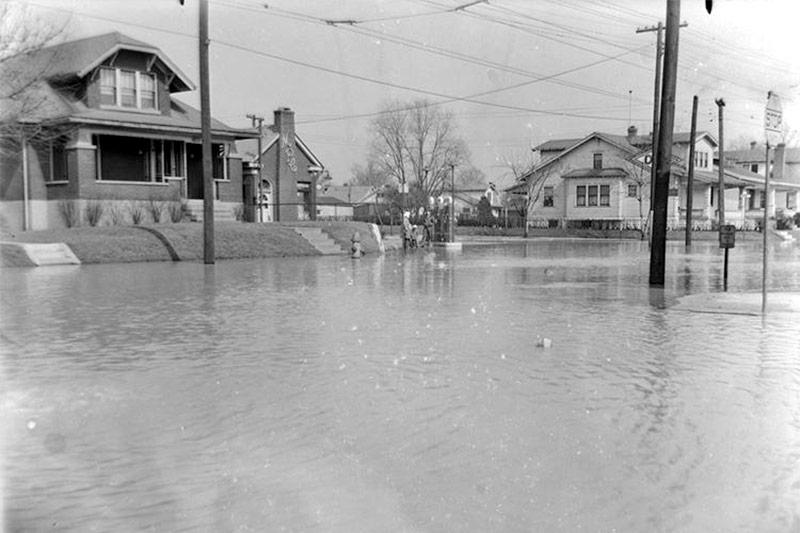We had no takers for our last sidewalk challenge. The view was taken on Zane Street looking toward Seventh Street in Old Louisville. We love the brick sidewalk peeking through an utterly snow-covered scene.
Here’s a new sidewalk challenge for this week. Here’s a new sidewalk ready to be identified in the comments below for your chance to win an official Broken Sidewalk magnet. This reader-submitted photo might be a bit of a challenge, but some of the buildings are still standing today, so here’s a hint: this flood took place in 1945. (The rules: Leave a real email so we can get in touch if you win; No repeat winners for four months; Comments must be left on this news roundup.) Good luck!
And now for the week’s top urbanism #cityreads in the news:
Cole: Los Angeles Mayor’s “I-Team” Seeks to Minimize Displacement During Urban Revitalization. Rick Cole, deputy Mayor for Budget and Innovation of the City of Los Angeles, gives an excellent and well meaning interview on how data could be used to create development without displacement in LA. The problem: he begins with a misconception about what drives development. See if you can spot it. The Planning Report
NYC Blitz of Help Could Reduce Poverty Rate by Up to 69 Percent. New York City is about to embark on a intersectional poverty mitigation project that will include increased minimum wage, more food stamp dollars, an earned income tax credit, and housing vouchers. Will this be the next leading idea in poverty alleviation or another stop gap measure? Next City
Homegrown Cities Project by URBZ. “Our contention is that only by working within the existing fabric and with local actors, can urbanists, architects, engineers and policy makers contribute meaningfully to ongoing user-lead improvement in homegrown neighbourhoods. This is why we have just launched the project Homegrown Cities that aims at demonstrating that common sensical alternatives to ‘redevelopment’ do exist.” Impact Design Hub
Little Grids: how small-scale utilities could solve America’s infrastructure woes. “Eric Zachrison explores the merits of thinking small, instead of big, when it comes to planning for basic public services.” The Global Urbanist
What Champions Of Urban Density Get Wrong. Inga Saffron bravely steps into the ring with the holiest of holies, urban density. Her critique centers around when and how we should create density and how die hard proponents of this ideology often become apostles to church of “instant urbanism,” giving little to no thought about where density will come from and how it will play out in the real world. Co.Design
The Value of Cheap Housing. An incredibly perplexing article by Sustainable Cities Collective in which they argue that Houston’s biggest strength as a city is its sprawl (equated to the creation of affordable housing), and the evidence of its success is how much growth its experiencing. Sustainable Cities Collective
Is Facebook’s ‘Zee Town’ more than just a Mark Zuckerberg vanity project? “In founding a town for some 10,000 of his employees to call their own, the Facebook mogul is following generations of entrepreneurs, from the Dutch East India Company to Walt Disney.” Guardian
How far a paycheck goes in 191 U.S. cities. Governing Magazine has an incredible map that shows the average hourly earnings by city as well as adjustments for costs of living. Governing Magazine
When Gentrification’s Neighborhood Name Game Runs Into True Identity. A “branding” game that everyone seems to hate but that always seems to creep into our urban discourse. Next City
The most unequal cities in the United States. “This data wouldn’t be particularly notable, but for a parallel reality playing out at the bottom: While the rich grew richer in each of these places, incomes for the poor didn’t budget at all.” The Washington Post: Wonkblog



This looks like 41st and market. That house further back is yellow now and the brick house is gone. Corner lot with a church across from the Academy @ Shawnee.